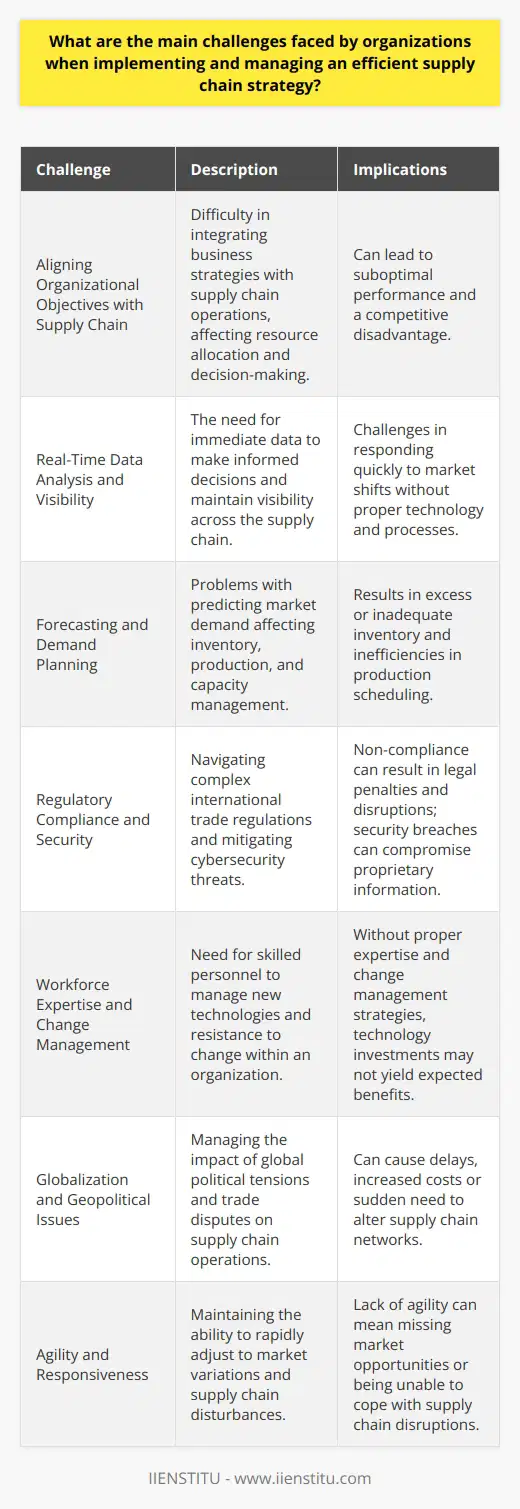
Supply chain management is an essential part of modern business. It is a complex process that requires careful planning, coordination, and execution in order to ensure that goods and services are delivered in a timely and cost-effective manner.
By leveraging the power of supply chain management, businesses can gain a competitive edge in their industry and significantly improve their operational efficiency. This article will discuss the key components of supply chain management, and how businesses can use them to their advantage. Through an understanding of the different elements of supply chain management, businesses can create a more efficient and profitable supply chain.
Introduction to Supply Chain Management
Benefits of Supply Chain Management
Components of Supply Chain Management
Strategies for Optimizing Supply Chain Management
Conclusion
Introduction to Supply Chain Management
In this article, we will explore the power of supply chain management, beginning with an introduction to the concept and its benefits. We will then look at the components of supply chain management, followed by strategies for optimizing it.
Finally, we will conclude with a summary of the key takeaways. Supply chain management is the management of the flow of goods and services, from raw material acquisition to finished product delivery, in order to meet customer requirements.
It involves the coordination and integration of all activities across the supply chain, from suppliers, through manufacturers, to distributors and retailers, to ensure that the right product is delivered at the right time, in the right quantity, and at the right cost. By leveraging the power of supply chain management, organizations can increase their efficiency, reduce costs, and improve customer satisfaction.
System Approach To Logistics Management For Packaging Handling
İmproving Supply Chain Management With Lean Theory Of Constraints And Six Sigma
Benefits of Supply Chain Management
The subject of this article is Harnessing the Power of Supply Chain Management, and the second section focuses on the benefits of such a system. Supply Chain Management (SCM) is an effective tool for businesses of all sizes, as it allows them to reduce costs, increase efficiency, and improve customer service.
SCM enables companies to better manage their inventory, which can lead to improved inventory control, reduced lead times, and increased customer satisfaction. Additionally, SCM helps businesses to identify potential risks and develop strategies to mitigate them. By utilizing SCM, companies can gain greater visibility into their supply chain, allowing them to make informed decisions that result in cost savings and improved performance.
Finally, SCM helps businesses to develop more effective partnerships with their suppliers, leading to improved quality and faster delivery times. By leveraging the power of SCM, businesses can gain a competitive edge and ensure their long-term success.
Components of Supply Chain Management
The third component of Supply Chain Management is the identification of the components of the chain. This includes the identification of the suppliers, manufacturers, distributors, retailers and other stakeholders that are involved in the chain.
It also includes the identification of the resources required to move the product from one point to another. This includes the identification of the transportation modes, warehousing requirements, inventory management techniques and other logistical considerations. Once the components of the chain are identified, it is possible to develop strategies to optimize the chain and maximize efficiency.
Strategies for Optimizing Supply Chain Management
The fourth subject heading of this article is Strategies for Optimizing Supply Chain Management. Successful supply chain management relies on the ability to effectively identify and manage the various components of the supply chain, as well as to develop strategies for optimizing the process.
These strategies can include the use of advanced analytics, the adoption of technology-driven solutions, and the implementation of effective supply chain management practices. Businesses should also consider the use of supply chain mapping to identify areas of improvement, as well as the development of collaborative partnerships with suppliers and other stakeholders.
Additionally, organizations should focus on the development of a culture of continuous improvement, which can help to ensure that supply chain processes remain optimized in the long-term. By harnessing the power of supply chain management, businesses can create a competitive advantage and ensure long-term success.
In conclusion, supply chain management is an invaluable tool for businesses of all sizes and industries. With the right strategies and components in place, businesses can maximize their supply chain operations and enjoy the many benefits that come with it, such as improved customer satisfaction, reduced costs, and increased efficiency. By harnessing the power of supply chain management, businesses can ensure their success in the long run and remain competitive in the market.
The strength of a business lies in the strength of its supply chain.
In summary, utilizing supply chain management methods can significantly enhance business operations and give them a competitive edge. Procurement of raw materials to the delivery of the final product, every step is vital and must be finely orchestrated to generate effective results. To maximize these benefits, businesses need to understand supply chain management thoroughly, identify key components, and devise strategies to optimize processes. Introduction to such strategies can be accessed via supply chain management courses free, providing an in-depth understanding of the process. Through continuous improvement and partners collaboration, businesses can experience improved efficiency, reduced costs, and elevated customer satisfaction levels, thus ensuring their long-term success.
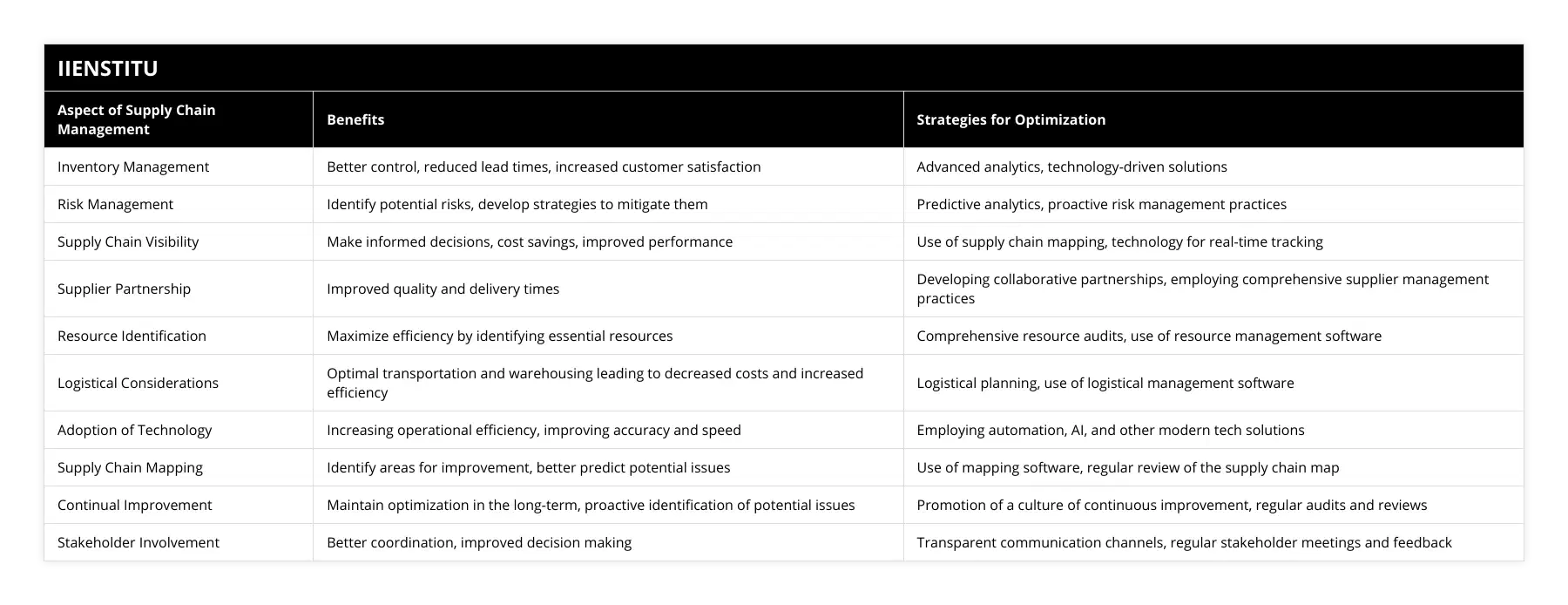
Supply chain management is crucial and vital for successful modern businesses, playing a pivotal role in ensuring goods and services are delivered effectively and cost-efficient. By using comprehensive strategies such as advanced analytics, technology-driven solutions, supply chain mapping, and fostering a culture of continuous improvement, companies can optimally manage the flow of goods and services to achieve customer satisfaction, cost-effectiveness, and operational efficiency. It can identify potential risks, lead to informed decision-making, and foster more effective partnerships for quality and faster delivery. With undergoing supply chain management certification online, businesses can equip themselves with essential knowledge and skills to harness the power of supply chain management and gain a competitive edge in their markets, thereby doing more than surviving, but thriving in their respective industries.
Frequently Asked Questions
What is the role of power dynamics in supply chain management?
Power Dynamics Definition
Power dynamics play a critical role in supply chain management by influencing decision-making, relationships, and strategies among various stakeholders. Simply put, power dynamics refers to the uneven distribution of power, resulting from differences in access to resources and the ability to influence outcomes.
Balancing Power in Relationships
In the context of supply chain management, power dynamics relate to the asymmetrical relationships that may exist among suppliers, manufacturers, and retailers. Imbalances of power may give certain stakeholders disproportionate control, enabling them to dictate terms, prices, and other factors that impact profitability and efficiency for others in the chain.
Examples include large buyers exerting their influence on smaller suppliers or dominant suppliers controlling production inputs affecting manufacturing processes. It is crucial to recognize these power imbalances and strive for more balanced relationships in supply chains, ensuring a collaborative environment and a shared commitment to success.
Strategies to Address Power Dynamics
Understanding the role of power dynamics in supply chain management enables stakeholders to adopt strategic approaches to mitigate negative impacts and promote cooperation. First, transparency plays a key role in improving the distribution of power. Open communication among stakeholders allows for better bargaining positions, more equitable contract terms, and increased trust.
Additionally, joint planning and collaboration help stakeholders work as a cohesive unit. Through joint planning, parties can align their objectives, share risk, and create a more equitable distribution of benefits.
Lastly, measuring performance enables stakeholders to identify areas where power imbalances are present and to develop corrective actions. Proper benchmarking and data analysis can reveal opportunities for improvement and foster a more balanced supply chain.
Conclusion
In conclusion, power dynamics have a significant impact on supply chain management by shaping relationships, decisions, and outcomes. Balancing these dynamics creates a more equitable, collaborative environment that ultimately benefits all stakeholders. Strategies such as promoting transparency, joint planning, and performance measurement can lead to improvements in operations, increased trust, and sustainable success.
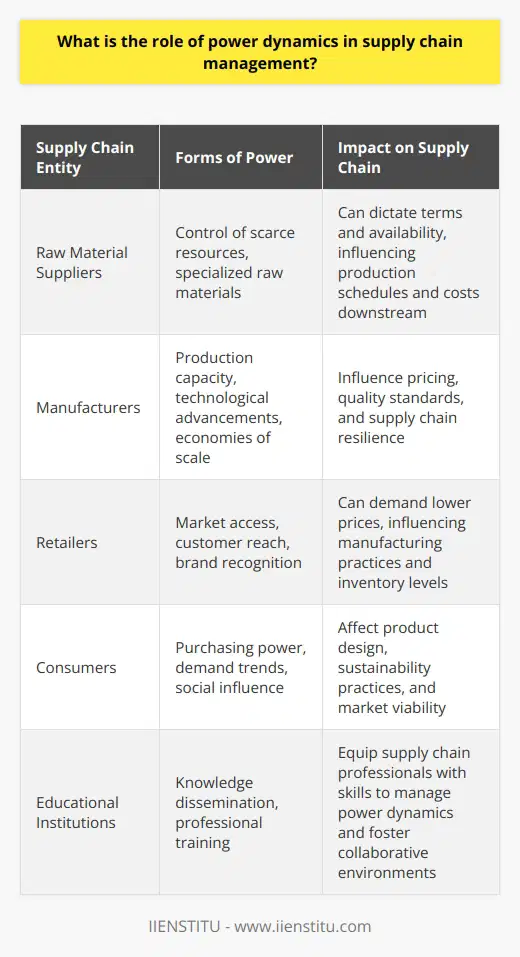
What are the primary factors that contribute to the success of a supply chain management strategy?
Effective Coordination and Collaboration
A successful supply chain management strategy primarily relies on effective coordination and collaboration among all stakeholders. This ensures smooth flow of information, resources, and products across the supply chain, leading to an optimized and efficient system.
Adoption of Technological Innovations
Embracing technological innovations is another vital factor that contributes to the success of a supply chain management strategy. By implementing cutting-edge technologies, such as artificial intelligence, automation, and blockchain, organizations can optimize their operations, reduce errors, and increase the speed and efficiency of their supply chains.
Risk Management and Adaptability
Proactively managing risks and fostering adaptability are essential aspects of a successful supply chain management strategy. By identifying potential risks, organizations can establish contingency plans and mitigation measures to minimize disruptions to their supply chains. Moreover, being adaptable allows organizations to respond to changing market conditions, evolving customer preferences, and emerging trends, ensuring their supply chains remain competitive and resilient.
Data-Driven Decision Making
Leveraging data and analytics for decision-making is another crucial factor for a successful supply chain management strategy. By collecting, analyzing, and interpreting relevant data, organizations can make informed decisions, identify opportunities for improvement, and implement strategies for increased efficiency and productivity.
Sustainability and Ethical Practices
Incorporating sustainability and ethical practices into the supply chain is also an essential element of a successful strategy. By adopting environmentally-friendly, socially responsible, and ethical practices throughout the supply chain, organizations can enhance their reputation, achieve regulatory compliance, and contribute positively to society and the environment.
Effective Communication and Transparency
Lastly, effective communication and transparency play a significant role in successful supply chain management. Constant communication and information sharing among stakeholders help to streamline processes, prevent misunderstandings, and foster trust. Transparency, on the other hand, ensures accountability and credibility, enabling organizations to build stronger relationships with their customers and partners.
In conclusion, a successful supply chain management strategy depends on effective coordination and collaboration, adoption of technological innovations, risk management and adaptability, data-driven decision-making, sustainability and ethical practices, and effective communication and transparency. By focusing on these factors, organizations can develop robust and resilient management strategies, ensuring the long-term success of their supply chains.
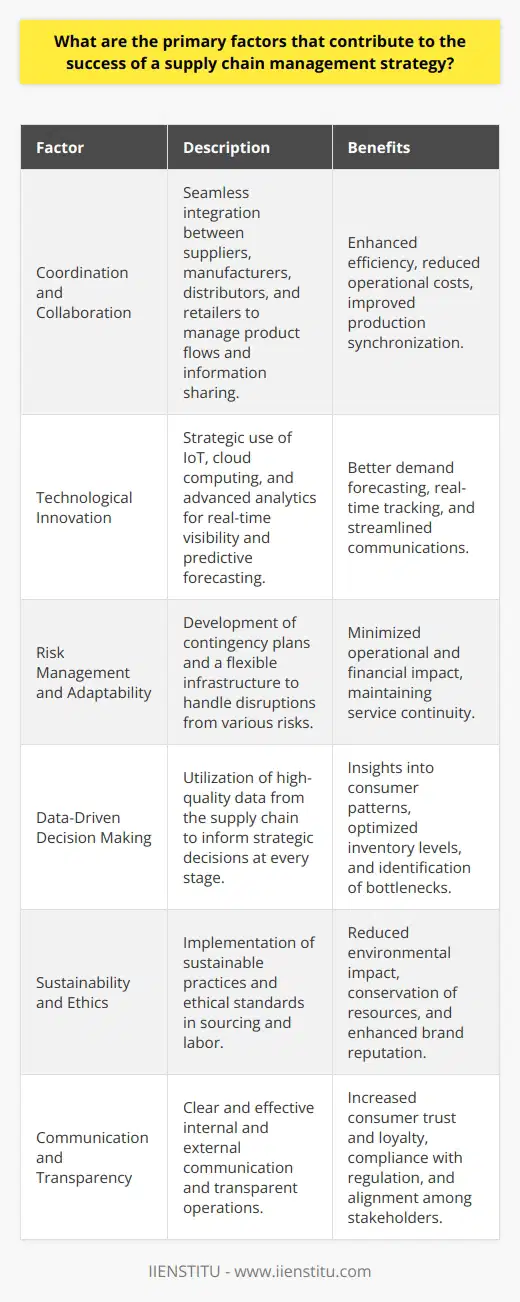
In what ways can organizations leverage technology to strengthen their supply chain management processes?
**Utilizing Technology Integration**
Organizations can use technology integration to reinforce their supply chain management processes. These technologies facilitate smooth operations by ensuring effective communication and coordination among different supply chain tiers. Enhanced coordination and communication provide increased visibility into the supply chain status, enabling organizations to identify and troubleshoot problems efficiently.
**Adopting Automation and AI**
Another way organizations can leverage technology is through the adoption of automation and artificial intelligence (AI). These systems help in streamlining repetitive tasks, improving efficiency, and ensuring accuracy. When utilized well, automation and AI can significantly reduce human error and time-consuming manual work, resulting in improved overall supply chain performance.
**Implementing IoT Solutions**
Internet of Things (IoT) solutions can also play a significant role in strengthening supply chain management processes. IoT devices capture and transmit data in real-time, allowing organizations to track inventory levels, monitor transport conditions, and optimize warehouse operations. This real-time data empowers organizations to make informed decisions, resulting in a more efficient, agile, and responsive supply chain.
**Data Analytics for Decision Making**
Organizations can improve their supply chain management by implementing data analytics tools. These tools help organizations collect, analyze, and interpret data related to various aspects of the supply chain, such as procurement, production, transportation, and distribution. By harnessing the power of data analytics, organizations can identify trends, recognize potential issues, and make informed decisions to enhance their supply chain efficiency and effectiveness.
**Enhancing Collaboration through Blockchain**
Lastly, organizations can leverage blockchain technology to boost their supply chain management. Blockchain facilitates secure, transparent, and traceable transactions, offering an efficient method to share and verify data between different supply chain stakeholders. By using blockchain, organizations can foster trust and collaboration among partners while maintaining data integrity and reducing the chances of fraud and errors.
In summary, organizations can strengthen their supply chain management processes through various technology implementations. Integrating technology in communication, automation, AI, IoT solutions, data analytics, and blockchain can result in enhanced efficiency, responsiveness, and overall supply chain performance. By embracing and adapting to these technologies, organizations can create a robust and competitive supply chain ready to face future challenges effectively.
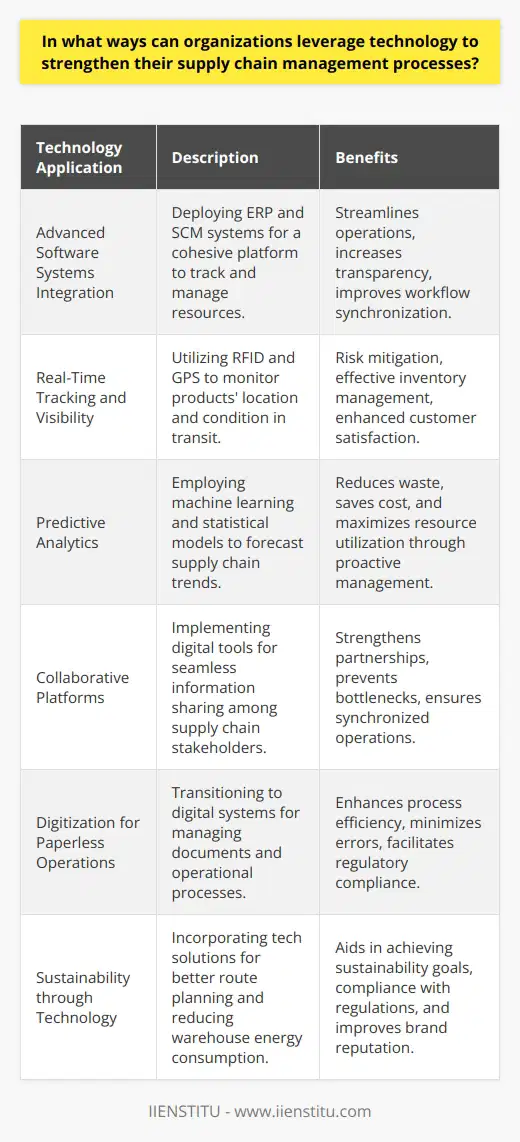
What is the significance of power dynamics in shaping supply chain strategies?
Understanding Power Dynamics in Supply Chains
The significance of power dynamics in shaping supply chain strategies lies in the ability to influence and control the actions and decisions of various stakeholders within the supply chain. These stakeholders include suppliers, manufacturers, distributors, and retailers, all of which contribute to the overall efficiency and effectiveness of the supply chain.
Influence on Stakeholder Decisions
Power dynamics can be categorized as either coercive or non-coercive in nature. Coercive power dynamics involve the use of threats or force, typically exercised by dominant players in the supply chain. Non-coercive power dynamics, on the other hand, rely on persuasion, collaboration, and incentives to influence stakeholder decisions. Understanding and leveraging these power dynamics enable firms to negotiate better terms with their supply chain partners, such as more favorable pricing, lead times, and payment terms.
Driving Supply Chain Performance
Furthermore, power dynamics can be utilized to drive supply chain performance improvement. For instance, a dominant buyer may exercise their power to enforce certain quality standards or delivery schedules, thus pushing their suppliers to adopt more efficient and effective practices. This, in turn, may lead to improved performance across the entire supply chain, ultimately benefiting all stakeholders involved.
Enhancing Collaboration and Cooperation
Additionally, the proper understanding and management of power dynamics can contribute to enhanced collaboration and cooperation among supply chain stakeholders. By recognizing and respecting each player's position and influence, stakeholders can work together more effectively to achieve their common goals. This collaboration also fosters information sharing, joint problem-solving, and mutual trust, which can be instrumental in navigating supply chain challenges and disruptions.
Supporting Innovation and Growth
Lastly, power dynamics play a crucial role in fostering innovation and growth within the supply chain. As stakeholders continuously strive to enhance their position and influence within the supply chain, they are motivated to adopt new technologies, invest in research and development, and implement innovative solutions – all of which contribute to the overall advancement and competitiveness of the supply chain.
In conclusion, power dynamics significantly shape supply chain strategies by influencing stakeholder decisions, driving performance improvement, enhancing collaboration and cooperation, and supporting innovation and growth. As such, appreciating these dynamics and leveraging them effectively are essential for organizations to successfully navigate the complexities of their supply chains and achieve a competitive edge in the market.
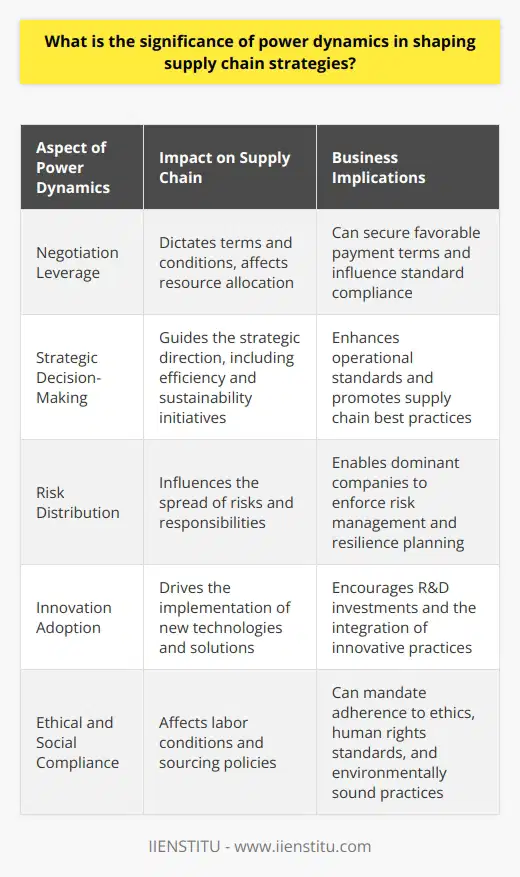
How can organizations identify and manage the key elements of their supply chain to enhance efficiency and competitiveness?
Identifying Key Elements
To enhance their efficiency and competitiveness, organizations must first identify the key elements within their supply chain. This can be achieved through supply chain mapping, which presents a visual representation of the complex network of suppliers, manufacturers, and distributors that collaborate to deliver a product or service to the customer. By identifying the most critical points, businesses can prioritize their efforts in refining and perfecting these processes.
Data Analysis and Monitoring
Data analysis and monitoring are essential tools for organizations to anticipate potential disruptions and enhance the efficiency of their supply chains. By gathering and analyzing data on various aspects of the supply chain, such as lead times, inventory levels, and supplier performance, organizations can make informed decisions to optimize their network. Regular monitoring also allows businesses to respond to changing trends, customer demands, and other external factors that may impact their competitiveness.
Effective Communication and Collaboration
Efficient supply chain management requires effective communication and collaboration among all stakeholders, from suppliers to end-customers. Open communication channels ensure better coordination, adaptability, and flexibility in managing challenges that may arise. Organizations must foster strong relationships with their supply chain members to encourage trust and cooperation, thereby ensuring a smoother flow of information and resources throughout the chain.
Technological Integration
The integration of technology within the supply chain is another crucial element for managing a competitive edge. Investing in modern systems and tools, such as enterprise resource planning (ERP) software, warehouse management systems (WMS), and transportation management systems (TMS), allows for greater visibility, accuracy, and control over various aspects of the supply chain. In addition, digital platforms also facilitate better communication, collaboration, and data exchange among supply chain partners.
Continuous Improvement
Finally, organizations must adopt a culture of continuous improvement to optimize their supply chain performance consistently. This involves regularly reviewing the efficiency of operations and innovating to find better and more effective ways to manage their networks. By implementing a continuous improvement mindset, businesses can identify new opportunities to enhance their competitiveness and respond to an ever-changing global market.
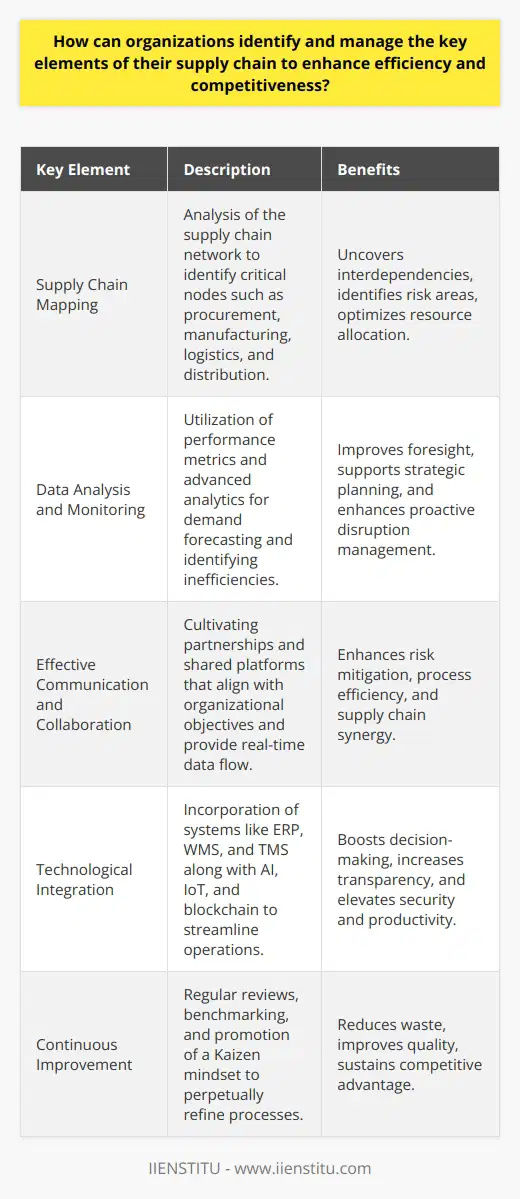
What are the best practices for implementing technology-driven solutions in supply chain management?
Identifying Effective Supply Chain Technologies
One crucial best practice is to diligently identify the most suitable technology-driven solutions to address specific supply chain challenges. This involves conducting an in-depth assessment of the given organization's pain points, goals, and resources to opt for technology solutions that are well-aligned with their particular requirements.
Enhancing Data Visibility
To optimize supply chain performance, augmenting data visibility and accessibility is of utmost importance. Implementing technologies such as the Internet of Things (IoT), blockchain, and advanced data analytics will allow organizations to track and manage relevant supply chain data effectively. This, in turn, enables better decision-making and monitoring of overall performance.
Emphasizing on Collaborative Efforts
Fostering a collaborative environment across the supply chain ecosystem becomes indispensable when implementing technology-driven solutions. Encouraging collaboration among internal and external stakeholders will support smooth technology adoption, align goals, and create a unified effort towards improving supply chain performance.
Investing in Employee Training
Successful implementation of technology-driven solutions necessitates that employees acquire relevant knowledge and skills to leverage these technologies effectively. This includes prioritizing ongoing employee training and development programs, as well as providing clear guidelines and support throughout the implementation process. In addition, creating a workforce that is well-equipped to navigate the rapidly changing landscape of supply chain technology promotes overall organizational resilience.
Prioritizing Scalability and Integration
Technological innovations often bring rapid changes; therefore, organizations must prioritize scalable and easily integrable technology solutions. Focusing on the solutions' compatibility with existing systems and their potential to adapt and grow with the organization's evolving needs will lead to a cost-efficient and sustainable approach to supply chain management.
Monitoring Performance and Adjusting Strategy
Lastly, organizations must continuously track the performance of the implemented technology-driven solutions with the help of relevant metrics and indicators. Monitoring the impact on supply chain performance allows for necessary adjustments to be made and assures that the chosen solutions continue to yield the desired results.
In conclusion, best practices for implementing technology-driven solutions in supply chain management involve a careful selection of suitable technologies, improving data visibility, fostering collaboration, investing in employee training, prioritizing scalability and integration, and continuously monitoring performance to adapt the strategy accordingly. These practices together ensure successful technology adoption and a sustainable, effective approach to supply chain management.

What are the key steps to ensure a successful supply chain management implementation?
Planning and Strategy
Successful supply chain management implementation begins with comprehensive planning and strategy. Defining clear objectives, understanding customer needs and aligning the supply chain processes to meet these needs are critical.
Resource Allocation
Effective resource allocation also contributes to successful implementation. This entails identifying the necessary staff, software, and equipment as well as the application of appropriate budget and time frames.
Training and Development
Equipping the team involved with necessary skills through training and development is a key step. A knowledgeable and competent team drives the successful implementation of supply chain management.
System Integration
A harmonious interaction between the different aspects of the system is essential. By integrating inventory, order management, and tracking system, an efficient and responsive supply chain is guaranteed.
Performance Management
Continual assessment and monitoring of the system's performance aid in identifying and resolving any issues. This encourages adjustments and improvements.
Vendor Selection
Successful supply chain management implementation requires strategic vendor selection. Choosing reliable vendors contributes to quality and timely supply of goods and services.
Risk Management
Identifying potential risks and developing mitigation strategies ensure business continuity. A risk management plan as part of the implementation process helps tackle unexpected supply chain disruptions.
Sustainability
Incorporating sustainability in supply chain operations not only ensure compliance with regulatory bodies, but also boosts the organization’s image and relationships with stakeholders.
Partnership and Collaboration
Nurturing partnerships and collaborations, especially with suppliers and transport companies, can optimize operations and improve the performance of the supply chain.
Continuous Improvement
Lastly, successful implementation of supply chain management is an ongoing process. It requires a commitment to continuous improvement, with regular reviews and revisions to the strategy and processes.
In conclusion, these are the key steps that ensure successful supply chain management implementation. It requires a strategic approach, allocation of resources, risk management, vendor selection and a continuous improvement mindset.
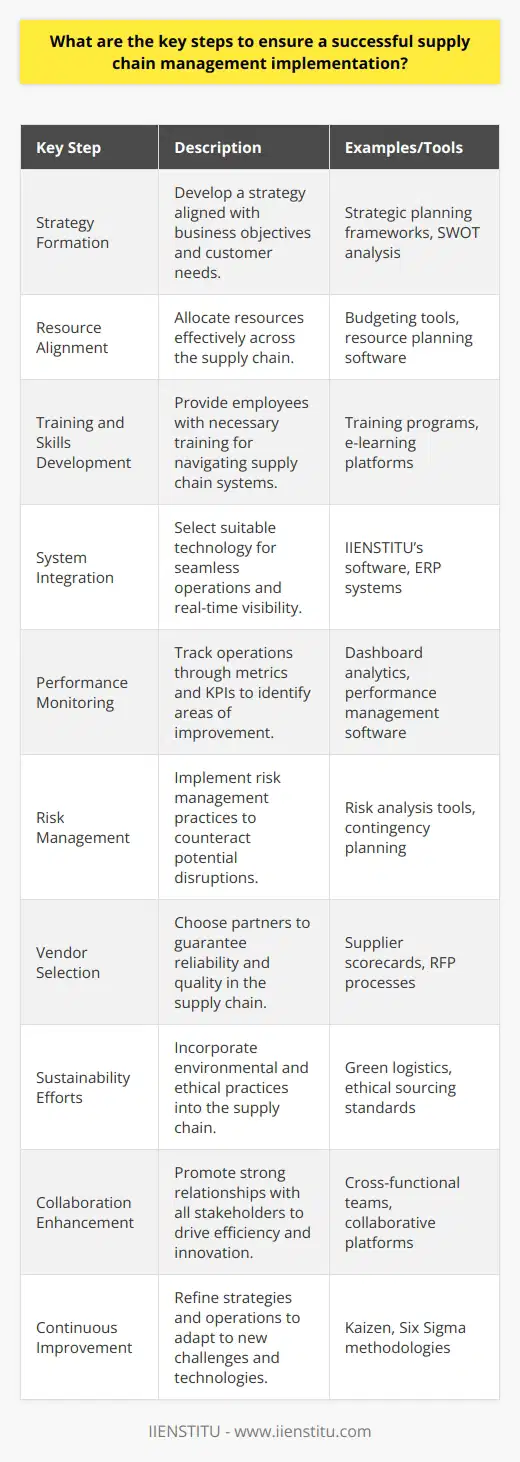
How do various power dynamics impact decision-making processes within supply chain management?
Influence of Hierarchical Power
Various power dynamics greatly impact the decision-making processes in supply chain management. Hierarchical power, for instance, affects the flow of information and decision-making. In a conventional top-down decision-making process, executives make the critical decisions with little or no input from middle and low-level managers.
Role of Collective Power
Contrarily, collective power compels organizations to encourage participation from various stakeholders. This encourages diversity of ideas, drives creativity, and fuels innovation. It unearths fresh perspectives, helping decision makers to foresee potential issues and explore a broad range of solutions.
Nature of Delegated Power
Delegated power in supply chain management allows specific team members to make autonomous decisions. This strengthens the sense of responsibility, creates efficiency in decision-making, and speeds up processes. However, adequate control measures must be in place to manage potential risks.
Implication of Bargaining Power
Bargaining power also plays a critical role. This is especially evident in negotiations with suppliers or customers. A strong negotiating position allows a company to secure favorable terms, enhancing profitability and competitiveness in the market.
Engagement of Expert Power
Finally, expert power plays a significant role in the decision-making process. Supply chain managers with professional reputation and in-depth knowledge often have the authority to make key decisions. Their expertise ensures reliable, well-informed decisions.
In conclusion, recognizing and managing these power dynamics can significantly enhance decision-making in supply chain management. Effective use of power can streamline processes, promote efficiency, and ultimately improve the overall performance of the supply chain.

What are the main challenges faced by organizations when implementing and managing an efficient supply chain strategy?
Supply Chain Strategy Challenges
One prime challenge organizations face while executing a supply chain strategy lies in integrating and aligning the flow of information. It requires effective communication within the company, as well as with stakeholders and partners.
Inventory Management Issues
Another problem is maintaining the right inventory levels. It necessitates a fine-tuned balance to avoid stock-outs and overstocks. Too little inventory can lead to missed sales, while too much can increase costs.
Supplier Relations and Risks
Managing supplier relationships and risks can also pose challenges. Companies often have multiple suppliers, making it crucial to maintain good relationships and manage risks effectively. Plus, globalization can introduce further complexities.
Advanced Technology Integration
The integration of advanced technology, such as artificial intelligence, into supply chain management can also become a hurdle. It requires significant investment and skilled workforce training.
Transportation Cost Management
In addition, controlling transportation costs is another critical issue. Rising fuel prices and logistical complications often lead to escalating transportation expenses. To manage this, organizations have to be adept at planning and route optimization.
Sustainability Concerns
Lastly, growing concerns about environmental sustainability are pressurizing organizations to incorporate green initiatives in their supply chain strategies. However, this can increase costs and require radical changes in operations.
In conclusion, effectively managing a supply chain strategy can be challenging due to the need to align information flow, manage inventory and supplier relationships, integrate technology, control transportation costs, and implement sustainability initiatives. Despite these challenges, however, a well-implemented supply chain strategy can reap significant benefits for an organization in the long run.
